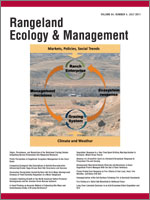Pseudoroegneria spicata (Pursh) A. Löve and Elymus wawawaiensis J. Carlson & Barkworth are two native perennial grasses widely used for restoration in the Intermountain West. However, the rapid establishment and spread of Bromus tectorum L., an invasive annual grass, has led to a decline in the abundance of native perennial grasses. Proliferation of B. tectorum has been attributed to its early germination, superior cold-temperature growth, profuse root production, and high specific leaf area (SLA). To enhance restoration success, we compared B. tectorum to commercially available plant materials of two perennial rangeland bunchgrasses, P. spicata (cv. Whitmar, cv. Goldar, and Anatone Germplasm) and E. wawawaiensis (cv. Secar), for germination, seedling morphological traits, and growth rates at the immature seedling stage. We monitored germination and immature seedling growth in a growth chamber in two separate experiments, one under low (5/10°C) and the other under high (15/20°C) day/night temperatures. Compared to the average of the two perennials, B. tectorum was 93% (77%) greater at high (and low) temperature for root∶shoot length ratio, but only 14% (14%) greater for root∶shoot biomass ratio and 12% (19%) lower for SLA. This suggests that B. tectorum's substantial investment in surface area of roots, rather than in shoot length, root biomass, or leaf area, may be responsible for the annual's success at the early seedling stage. Compared to E. wawawaiensis, P. spicata averaged 65% (41%) higher shoot biomass, 39% (88%) higher root biomass, and 70% (10%) higher absolute growth rate, but 25% (15%) lower SLA and 15% (36%) lower specific root length (SRL) at high (and low) temperatures, respectively. Although P. spicata's greater productivity may initially make for better seedling establishment than E. wawawaiensis, it may also prove disadvantageous in competitive or highly resource-limited environments where high SLA or SRL could be an advantage.
How to translate text using browser tools
1 July 2011
Immature Seedling Growth of Two North American Native Perennial Bunchgrasses and the Invasive Grass Bromus tectorum
Jayanti Ray-Mukherjee,
Thomas A. Jones,
Peter B. Adler,
Thomas A. Monaco
ACCESS THE FULL ARTICLE

Rangeland Ecology and Management
Vol. 64 • No. 4
July 2011
Vol. 64 • No. 4
July 2011
absolute growth rate
bluebunch wheatgrass
relative growth rate
Snake River wheatgrass
specific leaf area
specific root length




